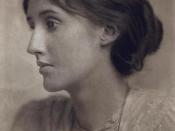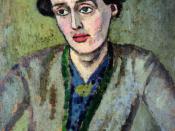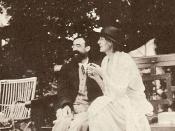Suspended in Time:
Virginia Woolf' Mrs. Dalloway
Virginia Woolf is forefront among modernist writers like T. S. Eliott and Joseph Conrad and is most notable for her stream-of-consciousness technique. Most critics cluster Woolf's Mrs. Dalloway with two of her own, Jacob's Room and To the Lighthouse as examples of a technique that represents a multi-narrative form. The result of this multi-point-of-view is a novel suspending time. Not only does time suspend for the reader, it also moves forward beyond the characters and consumes the text. Time, real or imagined, becomes the background of the novel. Ironically, the events occur in one day. Even so, the fixed time frame and Big Ben's reminder of progressive time are somehow slight. Nevertheless, Woolf professionally and purposefully moves through the narrative from one character to the next creating an effect of momentum in the mind of the reader. Furthermore, the "conscious" multi-narrative characters become the reason the reader is left "unconsciously" suspended in time.
As Johanna Garvey states: "the recurrent imagery?particularly that related to water?reinforces the impression that everything is running together, that consciousness and city are becoming indistinguishable" (60). Without boundaries, "time" flutters between reality and fantasy giving Mrs. Dalloway a "suspension then release" that permeates the novel.
At first, the temptation to stop and analyze the source of the narrative voice is unavoidable. Then, Clarissa, Septimus, Peter, and others appear to, as Joan Bennett believes "inhabit the mind of the reader and enlarge the capacity for imaginative sympathy" (42-43). Woolf, successfully, undermines the confusion caused by the transition between narrators by creating likeable characters with intriguing events. A crave to move through the novel, entering and exiting each character, is developed by Woolf's ability to move "from one mind to another are often more subtle than this?to the extent that...



Thesis is rather lose
the thesis of this paper is rather lose
1 out of 1 people found this comment useful.